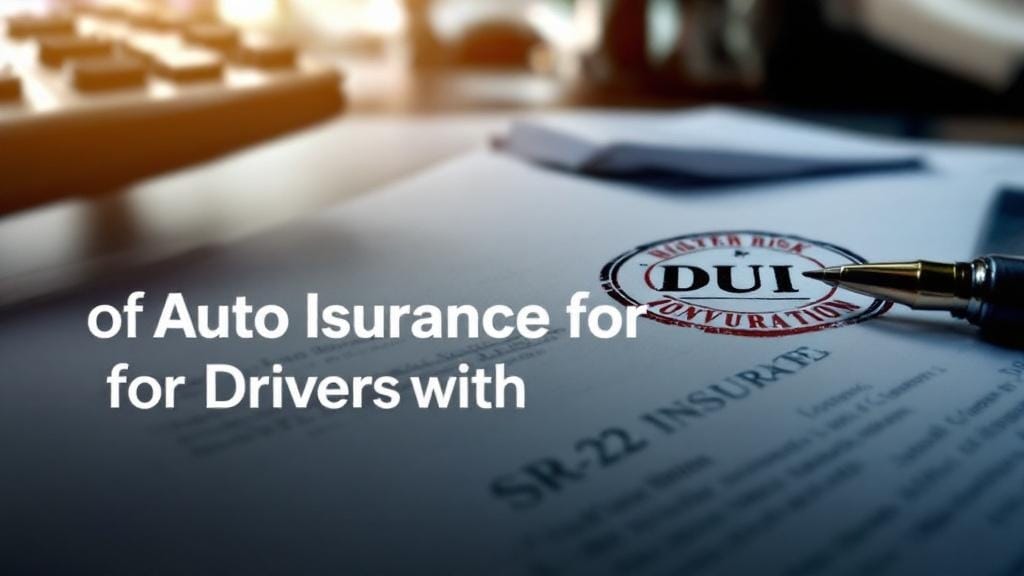In a world where nearly 90% of drivers legally need to carry auto insurance, understanding auto insurance regulations 2025 has become more crucial than ever. As we step into 2025, these regulations are evolving rapidly, shaped by advancements in technology, shifting consumer needs, and new legislative measures. But what exactly does this mean for you as a driver? Do you know your rights and responsibilities under these changing rules? This blog post will explore the latest updates in auto insurance regulations, delving into the major components that shape your policy, the trends influencing the industry, and the consumer protections designed to keep you secure. Whether you’re a seasoned driver or new to the road, staying informed about these developments ensures you make the best choices for your insurance needs.
Overview of Auto Insurance Regulations 2025
Understanding auto insurance regulations is crucial for both consumers and insurers, especially in 2025, when changes are rapidly evolving. These regulations serve to ensure that both drivers and insurance companies adhere to fair practices, providing essential coverage for road safety and financial protection.
Definition and Purpose
Auto insurance regulations are rules set by government authorities to govern how auto insurance policies are created, sold, and maintained. Their primary purposes include:
- Protecting consumers from unfair practices
- Establishing minimum coverage requirements
- Ensuring the financial stability of insurance providers
By understanding these regulations, consumers can make informed choices about their insurance coverage and know their rights when facing claims or services.
Importance of Understanding Regulations
With the advancement of technology and changing automotive landscapes, it’s more important than ever for individuals to be aware of auto insurance regulations. Here’s why:
- Avoiding Penalties: Understanding state-specific requirements can help you avoid fines or license suspensions.
- Better Coverage Options: Informed consumers can identify gaps in coverage and select policies that meet their needs.
- Empowered Decision-Making: Knowledge of regulatory changes enables consumers to engage more effectively with insurance providers.
For more detailed insights on auto insurance policies, you can visit Geico, a leading resource for understanding insurance products.
In the following sections, we will delve into the key changes, major components, and emerging trends of auto insurance regulations in 2025. Stay tuned to equip yourself with the necessary knowledge to navigate this landscape efficiently.
Key Changes in Auto Insurance Regulations for 2025
As we look into 2025, various reforms in auto insurance regulations are set to reshape the landscape for consumers and insurers alike. Staying vigilant about these updates can help drivers make informed decisions about their coverage.
State-Specific Variations
Auto insurance regulations can vary significantly from state to state, influenced by local laws and market conditions. It’s essential to understand these variations as they can directly impact your insurance needs. Notable changes include:
- Minimum Coverage Requirements: Some states may increase the minimum liabilities you must carry.
- Discount Eligibility: Different states may introduce new discounts based on safe driving records or versatile driving behaviors.
- Policy Cancellation Rules: Regulations surrounding the cancellation of policies might be revised, making them more consumer-friendly in some jurisdictions.
Federal Standards and Impacts
While state-specific regulations are crucial, federal standards also play a key role in shaping auto insurance rules. Changes influenced by broader federal policies can include:
- Data Privacy Regulations: Enhanced regulations around consumer data protection and privacy can affect how insurers share and store information.
- Insurance Affordability Measures: New federal guidelines may address the affordability of insurance, requiring insurers to provide lower-cost options for consumers.
Technological Advances in Regulation Compliance
The rapid growth of technology is also transforming auto insurance regulations. Here’s how:
- Telematics Programs: Many insurers are adopting telematics, which allows for monitoring driving habits. This data can directly influence premiums, fostering safer driving.
- AI and Automation: Insurers are increasingly using AI for fraud detection and claims processing, which can speed up responses and reduce costs.
Understanding these key changes in auto insurance regulations will better equip you to navigate your options in 2025. Being proactive ensures that consumers can take advantage of new benefits and protections as they emerge. For more details on auto insurance options and regulations, check out State Farm.
Major Components of Auto Insurance Regulations
Understanding the major components of auto insurance regulations is essential for navigating this complex landscape in 2025. These components dictate not only what is required from drivers, but also what consumers can expect from their insurance providers.
Coverage Requirements
Auto insurance regulations specify various types of coverage that drivers are required to carry. Key coverage types include:
- Liability Coverage: This is mandatory in nearly every state and covers damages to other people and property if you are at fault in an accident.
- Collision Coverage: This optional coverage helps pay for damages to your own vehicle after an accident.
- Comprehensive Coverage: This type of coverage protects against damages to your car from non-collision events, such as theft, vandalism, or natural disasters.
- Uninsured/Underinsured Motorist Coverage: This protection covers your expenses when involved in an accident with a driver who lacks adequate insurance.
Minimum Coverage Limits
Each state sets minimum coverage limits for liability insurance to ensure that drivers have adequate financial protection. For example:
- Bodily Injury Liability: May require minimum limits of $25,000 per person and $50,000 per accident.
- Property Damage Liability: Often requires a minimum of $10,000 to $25,000.
Being aware of these limits helps ensure you are compliant with local laws and protected against significant financial risks.
Rate Regulation
Insurance companies should operate under specific rate regulations to ensure fairness in premium pricing. Key elements include:
- Rate Approval Processes: Many states require insurers to seek approval before raising rates, which can prevent unjustified increases.
- Consumer Protections: Regulations often mandate clear communication of policy provisions and limiting premium hikes based on a single incident.
An understanding of these components allows consumers to choose suitable policies that align with their individual needs, thus enhancing their overall insurance experience.
For further insights on navigating auto insurance options, consider visiting Progressive, a leader in the auto insurance market that offers resources for consumers.
Trends Shaping Auto Insurance Regulations in 2025
As we progress through 2025, several trends are emerging that are fundamentally reshaping auto insurance regulations. Staying informed about these trends is vital for consumers and industry professionals alike.
The Impact of Autonomous Vehicles
The increasing presence of autonomous vehicles on the roads is necessitating a re-evaluation of existing auto insurance regulations. Key considerations include:
- Liability Issues: Determining who is at fault in accidents involving self-driving cars is complex and requires regulatory adaptation.
- Coverage Requirements: Traditional policies may need to evolve to address the unique risks posed by autonomous technology.
Climate Change Considerations and Environmental Regulations
Auto insurance regulations are increasingly factoring in climate change-related risks. This trend reflects a growing awareness of environmental factors that can impact the automobile sector:
- Natural Disasters: Coverage may need to include provisions for damages resulting from extreme weather events, such as floods and hurricanes.
- Sustainable Practices: Insurers might introduce incentives for electric or hybrid vehicles as a way to promote eco-friendliness.
Ride-Sharing and Commercial Use Adaptations
With the rise of ride-sharing apps like Uber and Lyft, auto insurance regulations are adapting to cover these new business models. Important aspects include:
- Commercial Coverage Options: Regulations are being revised to require specific coverage for drivers using personal vehicles for ride-sharing.
- Policy Customization: Insurers may offer tailored policies that account for part-time drivers who engage in ride-sharing alongside their personal use.
Understanding these trends is crucial for navigating the evolving landscape of auto insurance regulations. By staying informed, consumers can better protect themselves as regulatory frameworks adapt to the changing dynamics of transportation.
For further information on auto insurance developments, you can visit Allstate, a trusted resource for insurance insights and policies.
Consumer Rights Under Auto Insurance Regulations
Understanding consumer rights under auto insurance regulations is essential for drivers in 2025. These rights help protect consumers and ensure they are treated fairly by their insurance providers.
Transparency in Policy Information
One of the fundamental rights consumers have is the demand for clear and transparent information regarding their insurance policies. This includes:
- Clarity in Terms and Conditions: Insurance companies must provide clear explanations of coverage, exclusions, and limits.
- Accessible Policy Documentation: Consumers have the right to obtain copies of their policies and any amendments easily.
Claims Process and Consumer Protection
Navigating the claims process can be daunting, but auto insurance regulations provide consumer protections designed to make this process more straightforward:
- Timely Claims Handling: Insurers are typically required to process claims within a specific timeframe, reducing unnecessary delays.
- Fair Settlement Offers: Policies often stipulate that insurers must offer reasonable settlements considering the accident circumstances and damages incurred.
The Role of Insurance Ombudsman
In cases where disputes arise, consumers have access to an insurance ombudsman or regulatory authority that can help resolve issues. Important functions include:
- Mediation Services: The ombudsman can facilitate discussions between consumers and insurers to aid in resolving disputes.
- Investigative Powers: They can investigate complaints against insurers and ensure compliance with existing auto insurance regulations.
By understanding these consumer rights, drivers can advocate for themselves and ensure they are receiving the protections afforded by regulations. Being informed also enables consumers to hold insurers accountable for any unfair practices.
For more information on consumer rights and auto insurance details, you can visit Nationwide, a company committed to providing valuable resources and insights for consumers.
What to Expect for the Future of Auto Insurance Regulations
As the automotive landscape continues to evolve in 2025 and beyond, several trends and predictions are shaping the future of auto insurance regulations. Understanding these potential changes will help consumers and insurers alike prepare for what lies ahead.
Predicted Future Trends
Several emerging trends may significantly influence auto insurance regulations:
- Increased Personalization in Policies: Insurers may adopt more personalized coverage options based on individual driving habits, utilizing data analytics and telematics.
- Mobile and Digital Innovations: Mobile apps are expected to play a larger role in managing policies, filing claims, and communicating with insurers.
- Enhanced Risk Assessment: With advancements in AI and big data, insurance companies might improve their risk assessment processes, leading to more accurate pricing.
Potential Legislative Changes
Regulatory bodies are constantly reviewing existing laws, and consumers can expect potential changes that focus on consumer protection and fairness:
- Stricter Consumer Protections: New regulations may emerge that focus on ensuring consumers are treated fairly, which might include clearer penalties for insurers who delay claims processing.
- Sustainable Insurance Practices: As environmental awareness grows, regulations may increasingly focus on promoting green vehicles through discounts and incentives.
Importance of Staying Informed
In light of these possible changes, it is vital for consumers to stay informed about ongoing developments in auto insurance regulations. Awareness of new laws, technological advancements, and consumer protections helps drivers make informed decisions about their insurance coverage and choose insurers that align with their needs.
For further insights into the future of auto insurance, including the regulatory landscape, you can visit Farmers Insurance, a resource committed to helping consumers navigate insurance options effectively.
Conclusion
As we navigate the complexities of auto insurance regulations in 2025, it’s clear that understanding these rules is crucial for both consumers and industry professionals. The landscape of auto insurance is continually evolving, influenced by technological advancements, changing societal needs, and regulatory reforms.
Recap of Key Takeaways
- Understanding Regulations: Awareness of auto insurance regulations helps protect your rights as a consumer and ensures you are adequately covered.
- Adaptability: The insurance industry is adapting to emerging trends such as autonomous vehicles, climate change, and ride-sharing, prompting necessary regulatory updates.
- Consumer Empowerment: Knowing your rights within the framework of auto insurance regulations allows you to make informed choices and advocate for fair treatment from insurers.
Encouragement to Stay Engaged with Regulatory Changes
In a rapidly changing environment, staying informed is paramount. Regularly reviewing updates on auto insurance regulations will not just keep you compliant but also enable you to take full advantage of available benefits and protections.
Final Thoughts on Navigating Auto Insurance Regulations
By understanding the key components and emerging trends of auto insurance regulations, you’re better equipped to navigate this dynamic landscape. Whether you are a consumer seeking the best coverage options or an industry professional looking to keep pace with changes, having this knowledge is essential for making informed decisions.
For more resources and information regarding auto insurance regulations and your rights as a consumer, consider visiting Liberty Mutual, where valuable insights can help you navigate your options effectively.
FAQ
What are auto insurance regulations?
Auto insurance regulations are laws and guidelines established by state and federal authorities to govern how auto insurance policies are created, sold, and maintained. These regulations ensure fairness and transparency in the insurance market, protecting consumers and fostering competition among insurers.
How do state-specific auto insurance regulations differ?
State-specific auto insurance regulations can vary widely, reflecting local needs and market conditions. Each state sets its own requirements for minimum coverage, liability limits, and even how insurers should handle claims. Understanding these differences is crucial for drivers to ensure compliance and adequate coverage.
What consumer protections are included in auto insurance regulations?
Consumer protections in auto insurance regulations include rights such as clear disclosure of policy terms, timely claims processing, and the ability to contest unfair settlement offers. These regulations aim to empower consumers, ensuring they receive fair treatment and can easily navigate the claims process.
How will technological advancements impact auto insurance regulations?
Technological advancements, such as the rise of autonomous vehicles and telematics data, are prompting regulatory bodies to reevaluate existing auto insurance laws. Future regulations may focus on liability issues related to self-driving cars and adapt to new data-driven pricing models that reward safe driving behaviors.
What should I do if I believe my insurer is violating auto insurance regulations?
If you suspect that your insurance provider is violating auto insurance regulations—such as delaying claims or failing to provide clear policy information—you should first contact your insurer to discuss your concerns. If the issue remains unresolved, you can reach out to your state’s insurance department or a relevant regulatory authority for assistance and potential action.








Comments (0)